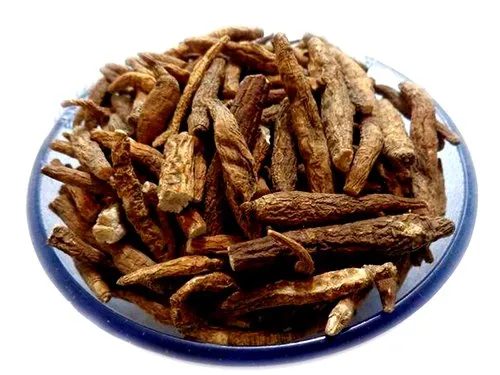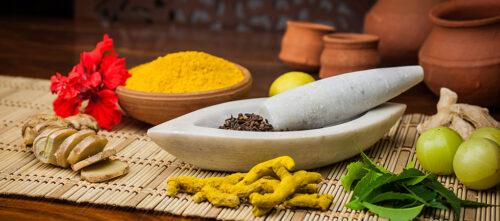Ayurveda is a traditional system of medicine that incorporates the offerings of nature to help people heal. Ancient Ayurvedic texts have mentions of an array of herbs that help treat different health conditions. Ativisha is one of them. The plant is known for its amazing medicinal properties and is especially used to treat diseases in children. According to Charaka, Ativisha is the best among all herbs for its digestive, anti-flatulent, absorbent and Dosha balancing properties. Ativisha – The Power Herb Ativisha (scientific name -Aconitum heterophyllum) is a herb native to the Himalayan area. The roots of this plant have been used for a broad range of medicinal purposes, which makes them highly valuable. Ativisha has a hot and pungent taste and is dry, light and penetrating in nature. The ability to balance the Tridosha and improve overall health is another essential characteristic of this power herb. As an Ayurvedic practitioner, I have seen a positive effect of this herb on my patients. I remember one child who had suffered from digestive problems and the constant increase of temperature several times a month. The conventional treatment did not bring results. However, after I began to use the herb, the issue was diminished. From this experience, I learned, once again, that every single philosophy holds some truth, and the power of nature may be undisputable. Ayurvedic Perspective on Ativisha In Ayurveda, Ativisha is classified as: Rasa (Taste): Bitter (Tikta) and Pungent (Katu) Guna (Qualities): Light (Laghu) and Dry (Ruksha) Virya (Potency): Cold (Shita) Vipaka (Post-Digestive Effect): Pungent (Katu) These properties make the herb effective in balancing Vata and Kapha Doshas while pacifying Pitta Dosha to a lesser extent. Health Benefits of Ativisha Here are a variety of health benefits that Ativish offers: Digestive Health Digestive issues are common, but they can significantly affect your quality of life. Ativisha is known for its ability to stimulate Agni, the digestive fire, which is essential for proper digestion and assimilation of food. By enhancing Agni, Ativisha helps in the breakdown of food, absorption of nutrients, and elimination of waste. It is particularly beneficial for individuals with weak digestion, loss of appetite, and abdominal discomfort. Also read: Agni- Ayurvedic Secret to Health and Vitality Fever Management Ayurveda widely uses Ativisha for its antipyretic properties. It helps in reducing fever by lowering the body temperature. It is often included in formulations for treating fevers, especially in children. Its antimicrobial properties help in fighting the underlying infections that cause fever, thereby providing relief and promoting recovery. Respiratory Health Respiratory conditions, such as cough, cold and asthma can be debilitating. Ativisha’s expectorant properties help in clearing the respiratory tract, making it easier to breathe. It reduces inflammation in the airways and, consequently, helps expel phlegm, thereby providing relief from symptoms. Regular use of Ativisha can improve respiratory health and prevent recurrent respiratory infections. Anti-inflammatory and Analgesic Properties Inflammation and pain are common symptoms in various health conditions, including arthritis and muscle pain. Ativisha has potent anti-inflammatory and analgesic properties; consequently, it helps reduce inflammation and, furthermore, alleviates pain. It, therefore, helps relieve joint and muscle pain and improves mobility. Gastrointestinal Health Diarrhoea and dysentery are common gastrointestinal issues that can lead to dehydration and weakness. Ativisha is highly effective in treating these conditions. It helps in controlling loose stools; furthermore, it also aids in reducing the frequency of bowel movements. Its antimicrobial properties combat the pathogens responsible for gastrointestinal infections, promoting faster recovery and improving gut health. Paediatric Care Children are often more susceptible to infections and digestive issues. Therefore, Ativisha is a safe and effective remedy for various childhood ailments. It helps in managing colic, fever, cough and diarrhoea in children. Besides, its gentle action ensures that it does not cause any adverse effects, making it suitable for paediatric use. Boosting Immunity A strong immune system is crucial for maintaining good health. Moreover, Ativisha has immunomodulatory properties that help in boosting the immune system. Regular use of the herb can enhance the body’s ability to fight infections and diseases, promoting overall health and well-being Practical Uses of Ativisha Some of the practical uses of Ativisha include the following: Decoction: Boil the roots of Ativisha in water and consume the decoction. This helps improve digestion and reduce fever. Powder: Consume it in powdered form with honey to treat respiratory problems and digestion. Infusion: The infusion of Ativisha can treat diarrhea and can also improve immunity. Uses in Ayurvedic Formulations Ativisha is a part of many Ayurvedic formulations. Churna: Ativisha, in its powdered form, can be mixed with other herbs to be consumed directly or mixed with honey or water. Kwath: It is prepared by boiling the roots of Ativisha in water. Kwath helps, in addition, to cure the issues of digestion, fever, cough and cold, and, furthermore, other respiratory problems. Taila: Applying Ativishaoil helps get rid of pain and inflammation in joints and muscles. Precautions and Safety Though it has numerous health benefits, you must use Ativisha with caution. The herb is quite potent; therefore, it is best not to use it frequently. It is important to consult with an Ayurvedic doctor, primarily in the case of children and pregnant females. Moreover, it should be consumed in the prescribed amount and form to avoid any possibility of side effects. If you are struggling with any health issues, you can either book a consultation with us or send us a message via WhatsApp to +91 79074 89839. We have the best Ayurvedic doctors in Trivandrum who are always glad to help you. If you have any queries, contact us. You can also visit us at our hospital.
Ativisha Health Benefits





